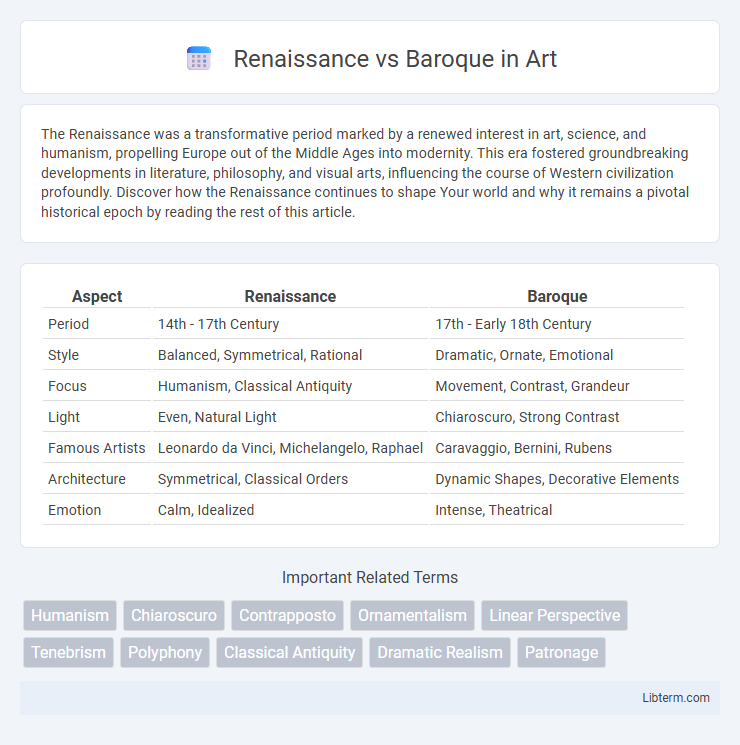The Renaissance was a transformative period marked by a renewed interest in art, science, and humanism, propelling Europe out of the Middle Ages into modernity. This era fostered groundbreaking developments in literature, philosophy, and visual arts, influencing the course of Western civilization profoundly. Discover how the Renaissance continues to shape Your world and why it remains a pivotal historical epoch by reading the rest of this article.
Table of Comparison
| Aspect | Renaissance | Baroque |
|---|---|---|
| Period | 14th - 17th Century | 17th - Early 18th Century |
| Style | Balanced, Symmetrical, Rational | Dramatic, Ornate, Emotional |
| Focus | Humanism, Classical Antiquity | Movement, Contrast, Grandeur |
| Light | Even, Natural Light | Chiaroscuro, Strong Contrast |
| Famous Artists | Leonardo da Vinci, Michelangelo, Raphael | Caravaggio, Bernini, Rubens |
| Architecture | Symmetrical, Classical Orders | Dynamic Shapes, Decorative Elements |
| Emotion | Calm, Idealized | Intense, Theatrical |
Introduction: Defining Renaissance and Baroque
The Renaissance period, spanning the 14th to 17th centuries, emphasized humanism, proportion, and classical harmony in art and culture. In contrast, the Baroque era, emerging in the late 16th century and continuing through the 17th century, is characterized by dramatic expression, movement, and ornate detail. These distinct artistic movements reflect shifting cultural values from balanced realism to emotional intensity and grandeur.
Historical Context and Timeline
The Renaissance period, spanning roughly from the 14th to the 17th century, emphasized humanism, classical learning, and balanced artistic compositions emerging from Italy's cultural revival. The Baroque era followed in the late 16th century through the early 18th century, marked by dramatic expression, grandeur, and heightened emotion in response to the Counter-Reformation and political absolutism in Europe. Both movements reflect distinct historical contexts where Renaissance art celebrated scientific discovery and proportion, while Baroque served as a tool for religious and monarchical power reinforcement.
Key Philosophies and Worldviews
Renaissance philosophy emphasized humanism, balance, and the revival of classical antiquity, promoting reason, individualism, and empirical observation as pathways to knowledge and artistic expression. Baroque philosophy embraced complexity, emotion, and dramatic tension, reflecting the Counter-Reformation's focus on spirituality, divine power, and the interplay between chaos and order. These contrasting worldviews shaped the art and culture of their respective periods, with Renaissance art highlighting harmony and clarity, while Baroque art emphasized movement, contrast, and emotional intensity.
Art and Visual Style Comparison
Renaissance art emphasizes symmetry, balanced proportions, and naturalism, featuring clear perspective and harmonious composition inspired by classical antiquity. Baroque art, in contrast, showcases dynamic movement, dramatic lighting (chiaroscuro), and intense emotional expression, often creating a sense of grandeur and tension. While Renaissance works prioritize clarity and order, Baroque visuals evoke theatricality and vivid contrast to engage the viewer's senses.
Architecture: Forms, Features, and Innovations
Renaissance architecture emphasizes symmetry, proportion, and geometry inspired by classical Roman design, characterized by columns, pilasters, and domes such as Brunelleschi's Florence Cathedral dome. Baroque architecture introduces dramatic contrasts, dynamic curves, and elaborate ornamentation, exemplified by structures like Bernini's St. Peter's Basilica and Borromini's San Carlo alle Quattro Fontane. Innovations in Baroque include the use of light and shadow to create emotional intensity and the integration of architecture with sculpture and painting to achieve a unified artistic experience.
Music: Composers and Characteristics
Renaissance music, characterized by polyphonic texture and smooth melodic lines, featured composers like Josquin des Prez and Palestrina who emphasized harmonic clarity and balanced, modal harmonies. Baroque music introduced dramatic contrast, ornate embellishments, and the use of basso continuo, with composers such as Johann Sebastian Bach and George Frideric Handel pioneering complex counterpoint and expressive dynamics. The shift from Renaissance to Baroque marked a move from restrained, intricate vocal music to energetic, instrumental-focused compositions emphasizing emotion and virtuosity.
Literature: Major Figures and Themes
Renaissance literature features major figures like Dante Alighieri, Petrarch, and William Shakespeare, emphasizing humanism, individualism, and classical revival themes. Baroque literature, represented by authors such as John Donne and Miguel de Cervantes, explores complexity, emotional intensity, and metaphysical themes often intertwined with religious and existential concerns. These contrasting literary periods highlight the shift from balanced harmony and rationality to dramatic expression and intricate symbolism.
Religious Influence and Iconography
Renaissance art emphasized balanced composition and harmonious proportions, reflecting a renewed interest in classical antiquity while integrating Christian themes through realistic human figures and serene religious iconography. Baroque art intensified emotional expression and dramatic contrasts of light and shadow, employing dynamic compositions and elaborate symbolism to evoke spiritual fervor and grandeur, often aimed at inspiring devotion during the Counter-Reformation. Both periods utilized religious iconography, but Renaissance works prioritized clarity and idealized beauty, whereas Baroque art focused on movement, theatricality, and direct emotional engagement with the viewer.
Impact on Modern Culture
The Renaissance period's emphasis on humanism and realistic representation laid the foundation for modern artistic techniques and cultural appreciation of individual expression. Baroque's dramatic intensity and emotional depth influenced contemporary theater, music, and architecture, inspiring dynamic creativity and sensory experiences. Both movements shaped Western culture by blending innovation with tradition, fostering a lasting legacy in visual arts, literature, and performance.
Conclusion: Legacy and Lasting Influence
Renaissance art emphasized balance, proportion, and harmony, laying the foundation for modern Western aesthetics, while Baroque's dramatic intensity and emotional depth influenced theatricality and dynamic composition in later art forms. Key figures like Leonardo da Vinci and Caravaggio exemplify these periods' enduring impact on painting, sculpture, and architecture. Their innovations continue to inspire contemporary artists and shape cultural heritage worldwide.
Renaissance Infographic

 libterm.com
libterm.com